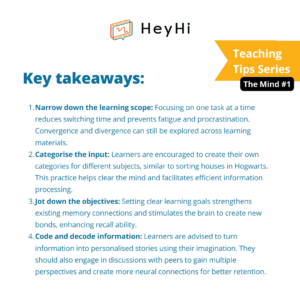Learners nowadays are bombarded with tons of distractions when going online, significantly impacting not only their learning ability but also their retention rate. In addition to using visual aids such as mind mapping or infographics, which can help retain information in a vivid and organised way, employing creative storytelling or mnemonic techniques can foster longer retention through meaningful connections in the brain.
Let’s embark on an inward journey to cultivate the ultimate learning mechanism by understanding how memories work in the digital age, starting with the Protégé Effect.
What is The Protégé Effect?
In simple terms, it’s about pretending to teach in order to acquire knowledge. However, it can also be applied to retain information over a long period of time through purposeful recalls. The more neural connections that are made, the easier and longer it is to remember.
Too big to swallow entirely?
Just like eating, the “brainfood” must also be softened and eaten gently, especially new ones. Overall, here is a checklist for educators to enhance their learners’ ability to remember:
- Narrow down the learning scope
- Categorise the input
- Jot down the objectives
- Code and decode information
More on the plate or the mind?
Instead of being a ‘jack of all trades,’ focusing on one task at a time helps reduce the switching time that later comes with tiredness and procrastination. That being said, concentrating on a single task doesn’t mean you cannot look for convergence and divergence across the learning materials. Whenever you feel lost or overwhelmed, recognize your limits and adjust the workload for other times.
Let’s imagine wearing the sorting hat!
Inspired by the houses in the magical school – Hogwarts in Harry Potter, educators should equip their learners with the ability to form their own “houses” for different subjects and actively sort any input using these imprinted categories.
Conventionally, learners can refer to the syllabus to categorise the input by subjects like Math house with formulas and numbers as frequent associations or Literature house with poems and longforms. In similar houses such as Math, Physics and Chemistry, another layer of sorting can be applied to quickly organise the input regarding their differences at source. Maths is usually taught via worksheets while Physics and Chemistry can be taught via real-life experiences. Furthermore, Physics and Chemistry experiments have different execution forms, thus, differentiate them from each other.
Other tags that can be used to sort the input are time/period, stakeholders, format/type, priority/urgency, sensory, etc. Learners can form their own tags by creating binaries like supported facts/empirical evidence versus hypothesis/rumours, actionable items versus plain statements, organic/nature versus artificial, etc. Although dichotomous thinking can smooth things out by relieving the learners from the anxiety of analysing complex inputs, it can numb learners’ sensibility for life nuances if being used as the only way to sort things out. (Bonfá-Araujo et al.)
The key success factor is how familiar learners are with the sorting system so that they don’t have to try hard to recall, thus, associating these houses with vivid personal experiences can boost the memorising even better.
Aiming not cramming
Our brain has its limits in recalling inactive memories; therefore, learning purposefully not only helps strengthen existing connections but also acts as a stimulus to push through brain fog, fostering the creation of new bonds. Goal setting for memory retention also requires good self-management abilities, which become invaluable during peak hours when there’s a wealth of information to digest. There are multiple goal setting models on the market but they all boil down to three questions:
- Why do I want to do this initially and now?
- What are the resources that I can think of now and pre-empt?
- What are the obstacles that I can think of now and pre-empt?
In answering these questions, learners should be as specific as possible to prevent any confounders in the execution. Keep going back and updating the goals to fit the situation if needed.
Let’s teach to learn!
After all the preparations, we arrive at the mock-teaching strategy, a truly beneficial approach for learners.
- CODE: Simple and Personal. Take the initial inputs and weave them into stories, drawing from personal life experiences and your imagination. Make the subject matter come alive with relatable tales.
- DECODE: Elaboration through Collaboration. Engage with a peer, or imagine one, and create a profile of them – who they are, their interests, and how familiar they are with the subject. Then, share your understanding of the material and discuss how they interpret it. Through this process, you’ll gain insights from at least three different perspectives on the input, enriched by the nuances of the discussion. As a result, you’ll form numerous neural connections, making the information easier to remember and retain for a longer time.
How can educators integrate the Protégé Effect in their online teaching?
Engaging learners in online teaching can be challenging. However, teachers can facilitate the first three steps by providing input break-down, categorization, and goal setting through well-planned modules.
Join hundreds of thousands of HeyHi users from over 20 countries in overcoming barriers to holistic and personalised learning now!
Step up your teaching with us at heyhi.sg.

